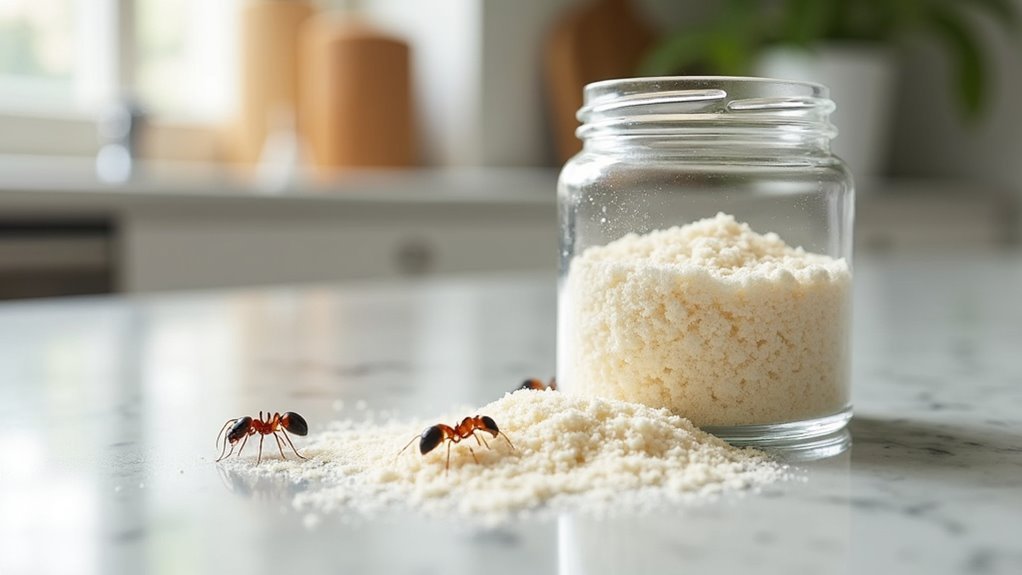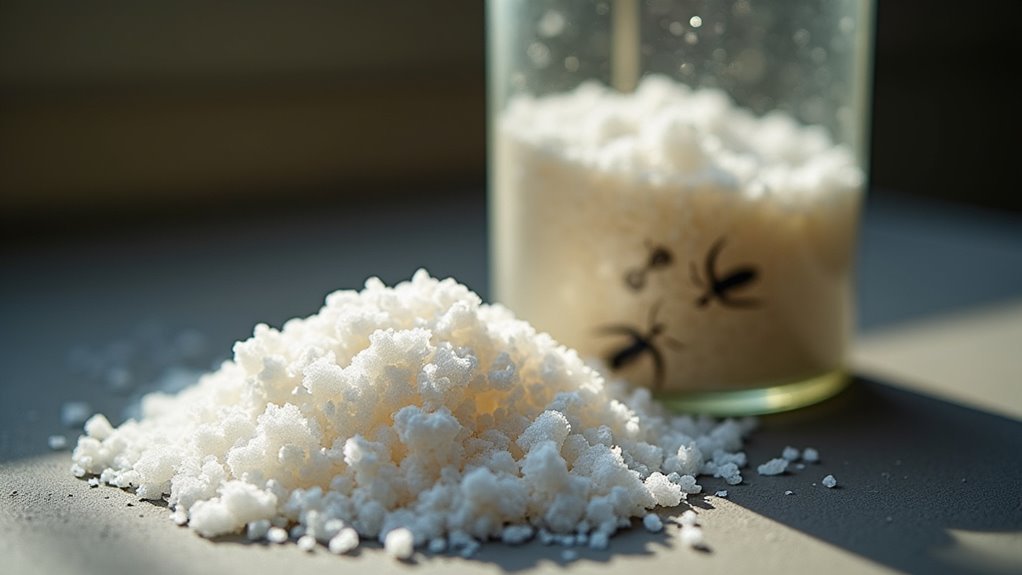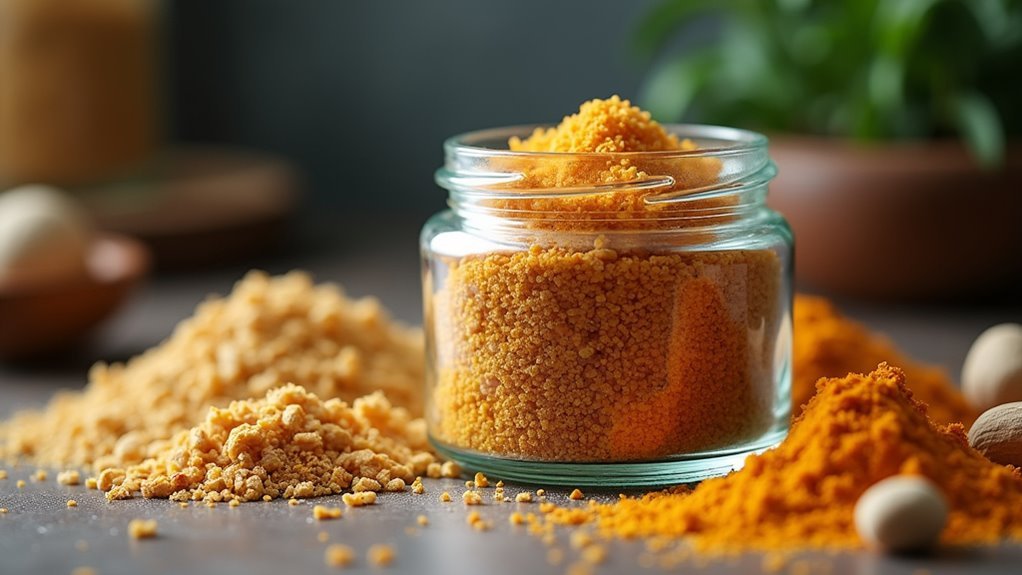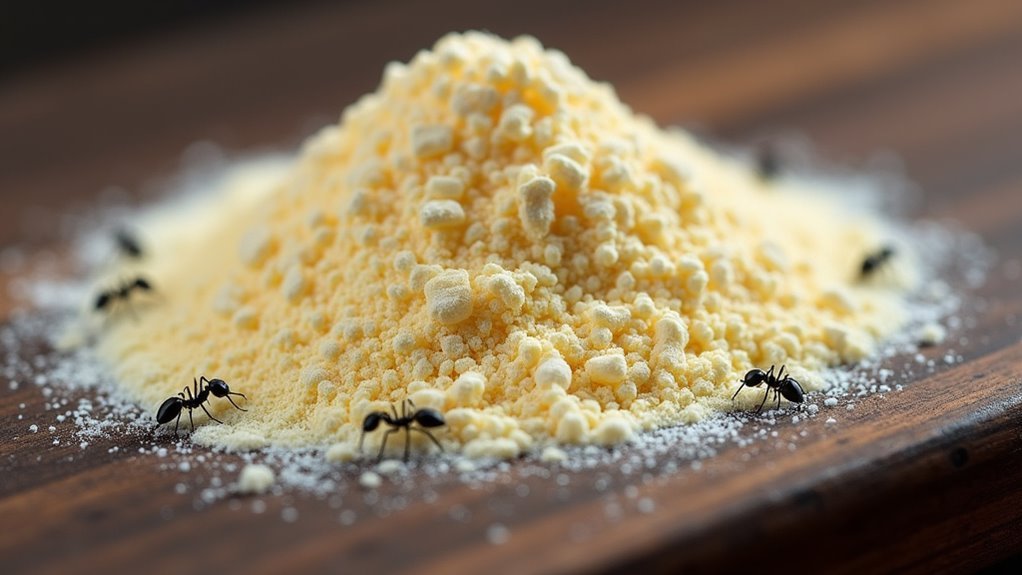You can create highly effective pest control baits by mixing boric acid with attractive food sources like flour, powdered sugar, and peanut butter. Use a 1:3 ratio of boric acid to attractants, then place these baits in dark, warm areas where cockroaches hide. The slow-acting poison disrupts their metabolism while they unknowingly spread contamination throughout their colonies through grooming behaviors. Proper application techniques and safety precautions will maximize your success against persistent infestations.
Understanding How Boric Acid Eliminates Household Pests

When boric acid contacts household pests, it launches a multi-pronged attack that makes it one of the most effective natural pest control methods available.
You’ll find this stomach poison disrupts insects’ metabolism when ingested, causing them to starve. The powder’s abrasive properties damage their exoskeleton, leading to fatal dehydration.
Boric acid creates a deadly double impact—disrupting insect metabolism from within while its abrasive texture damages protective exoskeletons externally.
What makes this effective solution particularly powerful for cockroach control is how pests carry it back to their nests during grooming. This slow-acting toxin allows infected insects to return home before dying, spreading contamination throughout the colony.
When combined with food attractants, boric acid targets cockroaches, ants, and termites while maintaining low toxicity levels, making it safe around your family.
Essential Safety Precautions When Handling Boric Acid
Three fundamental safety measures will protect you and your family when handling boric acid for pest control.
First, always wear gloves and a mask to prevent skin contact and inhalation. Keep boric acid in its original, tightly closed container with clear labeling, stored away from children and pets to prevent accidental ingestion.
Second, apply boric acid strategically in hard-to-reach areas like cracks and crevices. Avoid accessible surfaces such as countertops where children and pets might encounter it. This targeted approach maximizes effectiveness while minimizing exposure risks.
Third, monitor treated areas after application. Keep family members and pets away until the boric acid settles and becomes invisible.
Educate all household members about boric acid’s potential hazards and the importance of following these safety precautions consistently.
Selecting the Right Grade and Quality of Boric Acid

Beyond implementing proper safety protocols, you’ll need to select the appropriate grade and quality of boric acid to maximize your pest control efforts. Technical Grade Boric Acid proves most suitable for pest applications, as higher purity grades offer unnecessary costs without additional benefits.
| Factor | Recommendation |
|---|---|
| Grade Type | Technical Grade |
| Concentration | 10% in baits |
| Quality Source | Alliance Chemical |
| Application Method | Bait and dust |
You should purchase from reputable sources to guarantee effective results. Alliance Chemical Boric Acid delivers reliable quality that’s proven against resilient cockroach populations. A 10% concentration in baits demonstrates superior effectiveness compared to lower concentrations, providing longer-lasting pest control. Proper selection prevents resistance development in pest populations while enhancing your overall control strategies.
Creating Sweet and Starchy Bait Mixtures
You’ll need to master the classic dough recipe that combines boric acid with attractive ingredients cockroaches can’t resist.
The key lies in achieving ideal ingredient ratios that balance toxicity with appeal—too much boric acid repels pests, while too little won’t eliminate them effectively.
Start with the proven formula of 1/4 cup boric acid, 1/2 cup flour, and 1/4 cup powdered sugar for your foundation mixture.
Classic Dough Recipe
Four simple ingredients combine to create one of the most effective homemade cockroach baits you can make. This classic dough recipe targets cockroach infestations by combining their preferred food sources into irresistible bait stations.
| Ingredient | Amount |
|---|---|
| Boric acid powder | 1/4 cup |
| All-purpose flour | 1/2 cup |
| Powdered sugar | 1/4 cup |
Mix these dry ingredients thoroughly, then gradually add water or milk while stirring until you’ve formed a stiff dough. You can substitute peanut butter for added attraction. Wear gloves during preparation to avoid skin irritation. Shape the mixture into small balls, then apply small portions on wax paper squares. Place these effective pest control baits in warm, dark areas where roaches frequent for maximum results.
Optimal Ingredient Ratios
Getting the proportions right makes the difference between bait that attracts pests and bait that drives them away. For ideal ingredient ratios, you’ll want to use 1 part boric acid to 3-5 parts food attractants. This concentration keeps the boric acid effective while ensuring roaches aren’t repelled by its presence.
A proven formula combines 1/4 cup boric acid with 1/2 cup flour and 1/4 cup powdered sugar. You can boost attractiveness by adding small amounts of cocoa powder.
Mix these dry ingredients thoroughly, then add just enough water or milk to form a stiff dough.
Shape the mixture into small balls or discs for easy placement. When you apply baits consistently in roach-frequented areas, you’ll achieve effective pest control through proper ingestion and exposure.
Developing High-Protein Attractant Formulations

You’ll find that protein-rich ingredients like peanut butter and bacon grease create incredibly effective cockroach baits when combined with boric acid.
Start with a simple 1:3 ratio of boric acid to peanut butter, then experiment with adding crushed pet food or other high-protein attractants to boost appeal.
This protein-focused approach works because it taps into cockroaches’ natural feeding preferences while maintaining the low concentration needed to avoid repelling your targets.
Protein-Rich Bait Ingredients
Three primary protein sources form the foundation of effective cockroach bait formulations: peanut butter, crushed pet food, and bacon grease.
These protein-rich baits capitalize on cockroaches’ omnivorous nature and their attraction to high-energy foods, making them powerful attractant options for pest control.
When creating your bait mixture, you’ll want to maintain a low concentration of boric acid to prevent immediate death.
This allows cockroaches to return to their colony and share the toxicant with others.
A proven recipe combines 1 tablespoon of boric acid with 3 tablespoons of peanut butter, creating small dabs you can strategically place throughout infested areas.
Consistent application over several weeks guarantees effective control of entire cockroach populations through this transfer method.
Optimal Mixing Ratios
While the foundational 1:3 boric acid to attractant ratio provides proven results, fine-tuning your mixture ratios can dramatically improve bait effectiveness across different cockroach species and infestation levels.
You’ll want to maintain boric acid concentrations between 1:3 to 1:5 ratios with food attractants to guarantee your attract and kill control strategy remains effective.
When creating protein-rich boric acid baits, mix one tablespoon of the active ingredient with three tablespoons of peanut butter for ideal palatability.
You can enhance these ratios by incorporating bacon grease or crushed pet food without exceeding the foundational proportions.
These ideal mixing ratios prevent cockroaches from detecting the toxicant while guaranteeing they consume enough active ingredient to eliminate the colony through secondary poisoning effects.
Enhanced Attractant Effectiveness
Building on these proven ratios, developing high-protein attractant formulations takes your bait effectiveness to the next level by targeting cockroaches’ natural dietary cravings. High-protein attractants like peanut butter dramatically boost boric acid baits’ appeal to target insects. You’ll achieve superior results by combining multiple protein sources such as crushed pet food or bacon grease.
| Protein Source | Attractiveness Rating | Consumption Rate |
|---|---|---|
| Peanut Butter | High | 85% |
| Bacon Grease | Very High | 92% |
| Crushed Pet Food | Medium-High | 78% |
These enhanced formulations increase bait attractiveness while facilitating toxin spread through colony grooming and cannibalism behaviors. Continuous refinement based on pest behavior patterns guarantees your effective pest control strategy remains potent against evolving cockroach populations.
Achieving Optimal Boric Acid to Food Ratios
Getting the boric acid to food ratio right makes the difference between effective pest control and wasted effort.
You’ll want to maintain a 1:3 to 1:5 ratio of boric acid to food attractant for ideal results. This concentration guarantees roaches consume your homemade baits without detecting the bitter taste that could deter them.
Avoid using too much boric acid, as excessive amounts will repel roaches or kill them before they return to share the toxicant with their colony. This defeats the purpose of slow-acting elimination.
Instead, focus on creating appealing baits using sugar, peanut butter, or flour that match your target species’ preferences.
Consistent application over several weeks allows time for the entire colony to encounter and consume the bait, leading to effective population control.
Strategic Placement Techniques for Maximum Effectiveness
Where you place your boric acid baits determines how quickly you’ll eliminate the entire roach population.
Strategic placement focuses on warm, moist, dark areas where roaches naturally hide. Position baits under sinks, behind appliances, and in cabinet corners where you’ve spotted droppings or seen roach activity.
Place boric acid baits in warm, dark hiding spots like under sinks and behind appliances where roaches congregate.
Target high-traffic areas to maximize encounters with your boric acid mixture.
Use bait stations or wax paper squares to protect surfaces while keeping treatments accessible to pests but safe from children and pets. This approach guarantees effective pest control without contamination risks.
Check placements every few weeks and replace baits to maintain attractiveness, especially in areas with heavy roach activity.
Avoid wet locations and food preparation surfaces to preserve bait efficacy and prevent contamination.
Monitoring and Maintaining Your Bait Stations
Effective bait placement means nothing without proper monitoring and maintenance of your stations. You’ll need to check your bait stations every few days to assess roach activity and guarantee baits remain attractive. Replace baits that’ve dried out or been consumed, as fresh bait maintains effectiveness in your pest control strategy.
| Monitoring Task | Frequency |
|---|---|
| Check bait condition | Every 2-3 days |
| Replace consumed baits | As needed |
| Clean station areas | Weekly |
Use sticky traps alongside bait stations to gauge infestation levels and track your progress. Maintain a clean environment around stations by removing food debris and moisture sources—this encourages roaches to target your bait instead. Document activity changes and consumption patterns to refine your approach and maximize effectiveness.
Combining Boric Acid Baits With Other Control Methods
While boric acid baits serve as powerful standalone weapons against cockroaches, you’ll achieve superior results by integrating them into an all-inclusive pest management strategy.
Combining boric acid with sanitation measures creates a formidable defense—remove food and water sources around food preparation areas while deploying baits strategically. Implement exclusion tactics by sealing cracks and crevices to block entry points. This integrated pest management approach targets pests from multiple angles.
You can enhance effectiveness by pairing boric acid with diatomaceous earth or insect growth regulators for thorough coverage. These control methods address both immediate infestations and long-term prevention.
Consistently monitoring areas after application helps you identify ongoing activity and determine when additional measures are needed for optimal results.
Troubleshooting Common Application Problems
Even well-planned boric acid applications can encounter setbacks that reduce their effectiveness against cockroach infestations. When roaches aren’t responding to your baits, systematically evaluate your approach to identify the problem.
| Problem | Cause | Solution |
|---|---|---|
| Roaches avoid bait | Wrong food attractants | Test sugar, peanut butter, or bacon grease |
| Quick kills without spreading | High concentration | Reduce to 1:3-5 ratio (acid:attractant) |
| Decreased effectiveness | Old/contaminated bait | Monitor and replace regularly |
Apply baits in ideal areas like under appliances and cabinet corners where roaches travel. If they’re still not taking bait, experiment with different food attractants until you find what works. Always prioritize safety by keeping baits away from children and pets, especially in accessible areas.
Long-Term Pest Management Success Strategies
You’ll need to establish consistent monitoring schedules and strategic reapplication timing to maintain effective cockroach control beyond the initial treatment period.
Regular inspection using sticky traps helps you detect new activity early, while rotating between different bait formulations prevents roaches from developing resistance to boric acid.
You can’t rely on a single application to solve long-term infestations—successful pest management requires ongoing vigilance and adaptive strategies.
Monitoring and Reapplication Timing
Successful boric acid pest control requires consistent monitoring and strategic reapplication to maintain long-term effectiveness against cockroach populations.
You’ll need to regularly check bait stations and treated areas for signs of roach activity, particularly droppings, to gauge your boric acid’s effectiveness. Monitor these areas every few days to track cockroach movement patterns and identify high-traffic zones.
Reapply your boric acid bait every 2-3 weeks, or sooner if roaches consume it quickly. Adjust placement based on observed activity, focusing on newly identified hotspots.
Maintain detailed logs of monitoring results and reapplication dates to track progress effectively.
Resistance Prevention Methods
While boric acid remains highly effective against cockroaches, preventing resistance development requires strategic rotation of your pest control methods.
Don’t rely solely on boric acid—alternate between different toxicants and non-chemical strategies every few months to keep roaches from adapting.
Enhance your bait application by combining boric acid with attractive food sources like sugar or peanut butter.
This encourages consumption rather than avoidance behaviors that could lead to resistance.
Monitor roach activity patterns and adjust your application locations accordingly.
Proper exposure guarantees the poison’s slow-acting nature works effectively, allowing contaminated roaches to spread the toxicant throughout their nests.
Maintain excellent sanitation and seal entry points alongside your boric acid treatments.
This integrated approach creates an inhospitable environment that prevents long-term infestations and reduces resistance development opportunities.
Frequently Asked Questions
Can Boric Acid Be Used for Pest Control?
You can use boric acid for pest control as it’s an effective stomach poison against cockroaches, ants, and termites. It’s safer than synthetic insecticides while disrupting pest metabolism and causing dehydration.
Can You Mix Boric Acid With Food to Kill Roaches?
You can mix boric acid with sugar, flour, or peanut butter to create effective roach bait. Use one part boric acid to three-five parts food for best results that’ll poison roaches without repelling them.
Does Boric Acid With Lure Work?
You’ll find boric acid with lure works effectively against roaches. The food attractant draws them in while low boric acid concentrations guarantee they consume enough poison to kill both themselves and contaminate their colony.
Why Am I Seeing More Roaches After Boric Acid?
You’re seeing more roaches because boric acid disrupts their environment, making them more active while searching for food and water. It’s slow-acting, so increased activity occurs before the poison takes full effect.
In Summary
You’ve now mastered the fundamentals of boric acid food baits for effective pest control. Remember to prioritize safety, choose quality materials, and create targeted bait formulations that’ll attract your specific pest problems. Monitor your stations regularly, troubleshoot issues promptly, and integrate these baits with other control methods for maximum impact. With consistent application and patience, you’ll achieve long-term pest management success throughout your home.





Leave a Reply